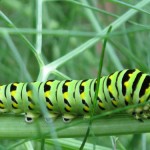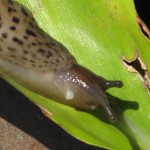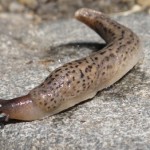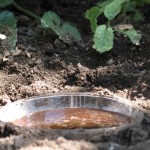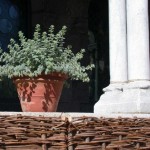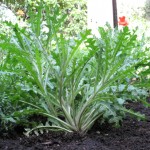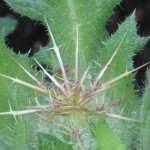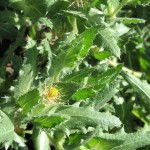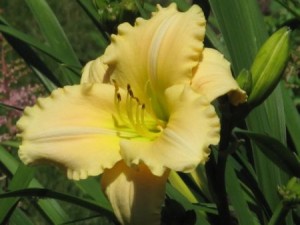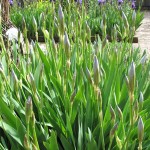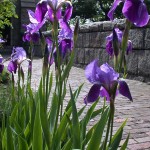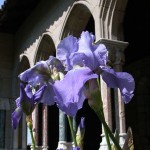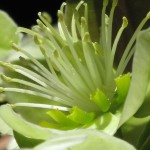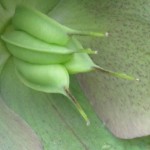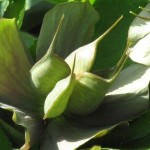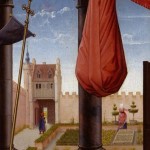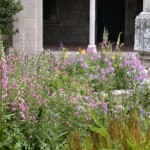Archive for the ‘Gardening at The Cloisters’ Category
Friday, September 24, 2010
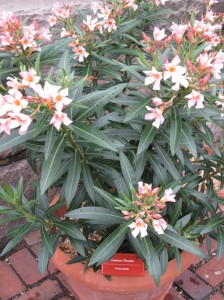
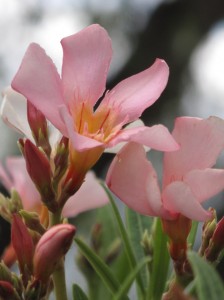
Above, from left to right: Nerium oleander, a tender evergreen shrub native to the Mediterranean, is grown in pots at The Cloisters and brought indoors for the winter. Oleander belongs to the Apocynaceae, or Dogbane family, which contains many poisonous species. The five petals of the oleander flower are fused at the base and form a tube; the form of the flower is typical of this botanical family. Photographs by Corey Eilhardt.
Nerion, which some call Rododaphne, some Rhododendron . . . grows in enclosed greens and sea-bordering places & in places near rivers. But ye flower and the leaves have a power destructive of dogs & of Asses & of Mules & and of most four-footed living creatures, but a preserving one of men, being drank with wine against the bitings of venemous beasts & ye more if you mixed it with Rue, but ye more weak sort of living creature, as goats & sheep, die, if they drink ye maceration of them.
???Dioscorides, De Materia Medica, Book IV, 82
Read more »
Tags: Apocynaceae, Dioscorides, Dogbane, Hortus Sanitatis, Nerium oleander
Posted in Gardening at The Cloisters, Medicinal Plants | Comments (2)
Wednesday, September 15, 2010
The Black Swallowtail (Papilio polyxenes) butterfly is commonly found in fields, gardens, and open spaces in the Northeastern United States. Above, left: The body of the fully developed caterpillar with its bold, bright bands of yellow, green, and black, is conspicuous against the feathery foliage of the fennel which is its favorite food; center: a female Black Swallowtail at rest on a salvia in Cuxa garden, as seen from above; right: the same butterfly seen in profile with its wings folded upward. Photographs by Corey Eilhardt.
We found several large, boldly marked caterpillars feeding on a stand of fennel (Foeniculum vulgare) in Bonnefont garden last month. We left them undisturbed, knowing from past experience that they would grow up to be beautiful eastern Black Swallowtail butterflies. Read more »
Tags: Apiaceae, Black Swallowtail, caterpillar, Fennel, Foeniculum vulgare, furanocoumarins, osmeterium, Papilio polyxenes, photodermatitis, phytotoxins, Ruta graveolens
Posted in Gardening at The Cloisters | Comments (1)
Monday, August 23, 2010
Above, left: The great gray slug, also known as the leopard slug because of the spots and streaks on its mantle, at home in Bonnefont garden. These nocturnal garden pests are not normally seen during daylight hours. This specimen was spied early one morning, and posed to have his-her portrait taken (slugs are hermaphrodites). Center: When fully extended, the adult slug can reach an impressive length. Right: A single strategically placed slug trap baited with beer will attract quite a few slugs. Photographs by Corey Eilhardt.
The great gray slug (Limax maximus) is also commonly known as the leopard slug because of the characteristic dark spotting on the mantle which covers the upper part of its body; the lower part of its body, known as the foot, is often streaked or striped. Leopard slugs vary in color from brownish green to gray, with whitish undersides. Adult slugs range from 4 to 8 inches in length. Read more »
Tags: carnivore, clary sage, detrivore, gastropod, great gray slug, herbivore, leopard slug, Limax maximus, malacologist, mandrake, mollusc, pest, Salvia sclarea, slug, slug trap, stout
Posted in Gardening at The Cloisters, Plants in Medieval Art | Comments (1)
Friday, August 6, 2010
Above: The left and center image show the true or “right dittany” of Crete (Origanum dictamnus), a tender Mediterranean species grown in pots in Bonnefont garden. This pretty relative of the culinary oreganos is endemic to the island, and is found growing wild only in the mountains there. The small, purplish-pink flowers are borne on long-lasting bracts in late summer and fall. The image on the right shows Dictamnus albus, known as white dittany or fraxinella, which is a botanically unrelated species. Medieval herbalists seem to have transferred both the name and the??marvelous properties that the ancients ascribed to true dittany to this herb.
Origanum dictamnus, with its round, woolly gray leaves,??rosy??bracts and delicate purplish-pink flowers, is the prettiest of the tender medieval species grown in pots in Bonnefont garden, and the most difficult for us to grow. One of a number of species endemic to the mountains of Crete, the wild plant is only found growing in the crevices of limestone gorges and ravines (see image). Known as diktamnon in Greek, it is said to be named after Mount Dikti. Read more »
Tags: Aeneas, antidote, Aristotle, artemidon, Artemis, Bonnefont Garden, Cos, Crete, diktamnon, Dioscorides, Hellmut Baumann, Hippocrates, Mount Ida, Origanum dictamnus, snake, snakebite, Theophrastus, venom, Venus, Virgil, William Turner
Posted in Fragrant Plants, Gardening at The Cloisters, Medicinal Plants | Comments (1)
Friday, July 30, 2010
Above: Three images of the blessed thistle (Cnicus benedictus). The low stature and unremarkable appearance of this plant belie its medieval reputation as a plague cure and a panacea. The lax stems and spiny, light green leaves are covered with a fine, white down; the spines that subtend the developing flowerhead are a protection against grazing animals. The yellow flowers of this annual thistle appear in July; once the seeds have set, the plant dies. Photographs by Corey Eilhardt.
The humble Cnicus benedictus, a plant of waste ground and stony soil native to the Mediterranean, was a medieval panacea whose reputation survived undiminished into the Renaissance. The sixteenth-century English herbalist John Gerard notes that this wild medicinal plant of southern Europe was “diligently cherished in gardens in these Northern parts.” Gerard also attests that the herb was known everywhere in Europe by the medieval Latin name Carduus benedictus; the common names by which it is known today preserve this designation: blessed or holy thistle in English, benedikten distel in German; chardon b??nit or chardon santo in French, cardo benedetto in Italian, cardo bendito in Spanish.
Read more »
Tags: bitter, blessed thistle, Carduus benedictus, carline thistle, cataplasm, cnecos, Cnicus benedictus, Dioscorides, earbes Carduus Benedictus and Angelica, invasive, John Gerard, Maude Grieve, panacea, pestilence, plague, Pliny, Rufinus, Silybum marianum, thistle, Thomas Brasbridge, weed
Posted in Gardening at The Cloisters, Medicinal Plants | Comments (1)
Monday, July 5, 2010
Above, left: Jane Hayward in Cuxa garden on July 5, 1993. Jane happily wears a crown of daylilies for the ceremonial planting of a??newly introduced cultivar??named for her that year. Right: Detail of Hemerocallis ‘Jane Hayward’ now blooming in Cuxa garden.
In 1993, Jane Hayward, a curator for the department of Medieval Art and The Cloisters, and an authority on stained glass, had recently celebrated her twenty-fifth anniversary working at the Museum. As passionately devoted to medieval art and to The Cloisters as she was, Jane also had a passion for daylilies,??declaring that??her idea of immortality would be to have a daylily named after her. Read more »
Tags: daylily, Jane Hayward
Posted in Gardening at The Cloisters | Comments (12)
Tuesday, May 18, 2010
Above, left and center: Blue-white orris and deep purple iris blooming simultaneously in Bonnefont Cloister garden. In the Middle Ages, the aromatic rhizomes of orris (Iris germanica var. florentina) were exploited for their fragrance. The purplish juice squeezed from the flowers of Iris germanica was mixed with alum to make a green used in manuscript illumination. Right: The beautiful and sweetly scented Iris pallida blooming in Trie Cloister garden.
And I must not pass you by, my iris, in silence.
Latin, that rich and eloquent tongue, has given you
The name Gladiola, made from its word for a sword.
For me at the start of summer you put forth
The beauty of your purple flower. . . .
. . . With your help too
The laundryman can stiffen his shining linen
And scent it sweetly.
???Excerpts trom the Hortulus of Walahfrid Strabo (ca. 808???849), translated by Raef Payne.
Due to the extraordinarily warm temperatures in early April, many plants bloomed as much as a month early this spring, and out of their usual sequence. Some plants that ordinarily bloom in succession bloomed simultaneously, including our beautiful bearded iris. Read more »
Tags: iris, Iris germanica, Iris pallida, orris, Walahfrid Strabo
Posted in Gardening at The Cloisters | Comments (2)
Monday, April 12, 2010
Above, from right to left: The showy stamens of the hellebore will shrivel and drop off, but the flowers will be attractive for many weeks more; the long-lasting sepals and the seed capsules they surround provide a second phase of beauty and interest; the sepals and seed capsules darken in color as they mature. Photographs by Corey Eilhardt.
Hellebores are among the earliest flowers to come in our gardens, but they are slow to go, unlike the snowdrops that bloom only for a short while in late winter and early spring. The hellebore flowers that appear in February-March lose their showy stamens in April, but the persistent sepals and the ripening seed capsules are beautiful and will last for many weeks longer.
There are some twenty species of Helleborus, native to Europe, Turkey, and the Caucasus, and many crosses have now been made between them.??Since these??cultivated forms are beautiful, various, hardy, undemanding, vigorous, and drought-tolerant, they have become very popular garden plants. Hellebores are now being bred to??bear more upright flowers, so they can be more easily admired, and a wide variety of colored and freckled forms, including blue and black-flowered cultivars, are available to collectors. For information on hybrid forms, see “Hybridizing Helleborus niger (PDF)” on the Royal Horticultural Society website.
These winter-blooming plants are dormant in summer, and cope well with dry shade; they require little maintenance beyond the removal of old foliage in fall or late winter. They self-seed freely and are easily propagated by division. For comprehensive information on knowing and growing them well, see Hellebores.
For a history of????hellebore species??used in??ancient and medieval medicine, see “Hell Flowers,”??March 24, 2010.
???Deirdre Larkin
Tags: hellebore, Helleborus foetidus, Helleborus niger, Helleborus orientalis
Posted in Gardening at The Cloisters | Comments (2)
Monday, March 15, 2010
Between the level turf and the herbs let there be a higher piece of turf made in the fashion of a seat, suitable for flowers and amenities; the grass in the sun???s path should be planted with trees or vines, whose branches will protect the turf with shade and cast a pleasant refreshing shadow.
???Book VIII, Chapter I: “On small gardens of herbs.” Piero de’ Crescenzi, Liber ruralium commodorum (1305-09). (See Catena, the Bard Graduate Center???s Digital Archive of Historic Gardens and Landscapes for more information.)
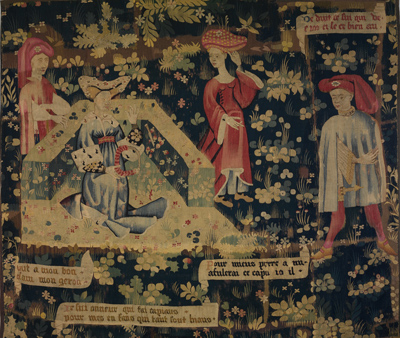
Above: Honor Making a Chaplet of Roses, ca. 1425???1450. South Netherlandish. Wool warp, wool wefts; 93 x 108 in. (236.2 x 274.3 cm). The Metropolitan Museum of Art, New York, The Cloisters Collection, 1959 (59.85). See the Collection Database to learn more about this work of art.
Turf benches were among the most distinctive features of medieval gardens, and are depicted in many paintings and tapestries. Such benches may be rectangular, circular, L-shaped, or U-shaped; the U-shaped type is known as an exedra. Regardless of their shape, the benches were usually constructed with low-walled frames made out of brick, wood, stone, or wattle (woven willow). The frames were then filled with soil and the surfaces were topped with turf. Turf seats were placed in the middle of the garden or against one of its walls, and were sometimes incorporated into the enclosure. Arbors or trellises were sometimes built into the seat to provide shade and shelter, while circular benches were constructed around single trees. Read more »
Tags: bench, exedra, Lady Honor, Piero de' Crescenzi, tapestry, turf, wattle, willow
Posted in Gardening at The Cloisters, Plants in Medieval Art, The Medieval Garden | Comments (19)
Friday, February 5, 2010
Above, from left to right: Detail from The Annunciation (17.190.7); Detail from The Unicorn in Captivity (37.80.6); Trie Cloister Garden in bloom.
???fruit trees that grow easily, such as cherries and apples, should be planted in place of walls; or, what is better, willows or elms or birch trees should be planted there, and their growth should be controlled for several years, both by grafting and by stakes, poles, and ties, so that walls and a roof might be formed from them.
???Book III: “On the Gardens of Kings and other Illustrious Lords.” Piero de’ Crescenzi, Liber ruralium commodorum (1305-09). (See Catena, the Bard Graduate Center’s Digital Archive of Historic Gardens and Landscapes for more information.)
In my undergraduate studies in landscape and architecture, I examined how the natural landscape is used to determine designs for parks, gardens, and public spaces. I took part in several design processes, which included research on site analysis, interviewing potential patrons of public spaces, building models of future designs, and using plants to blend artistic design with nature. I learned to look at the land as a palimpsest rather than a blank slate, and to examine its many layers of use throughout history, understanding that context is an important influence on new designs. Now, as the new assistant horticulturist here at The Cloisters, I’ve found more levels of meaning to my studies, and am inspired to think about design issues from a landscape historian’s perspective. Read more »
Tags: architecture, chastity, design, landscape, park, Piero de' Crescenzi, pomegranate, Punica granatum, Unicorn in Captivity, Unicorn tapestries, Virgin
Posted in Gardening at The Cloisters, Plants in Medieval Art | Comments (4)



